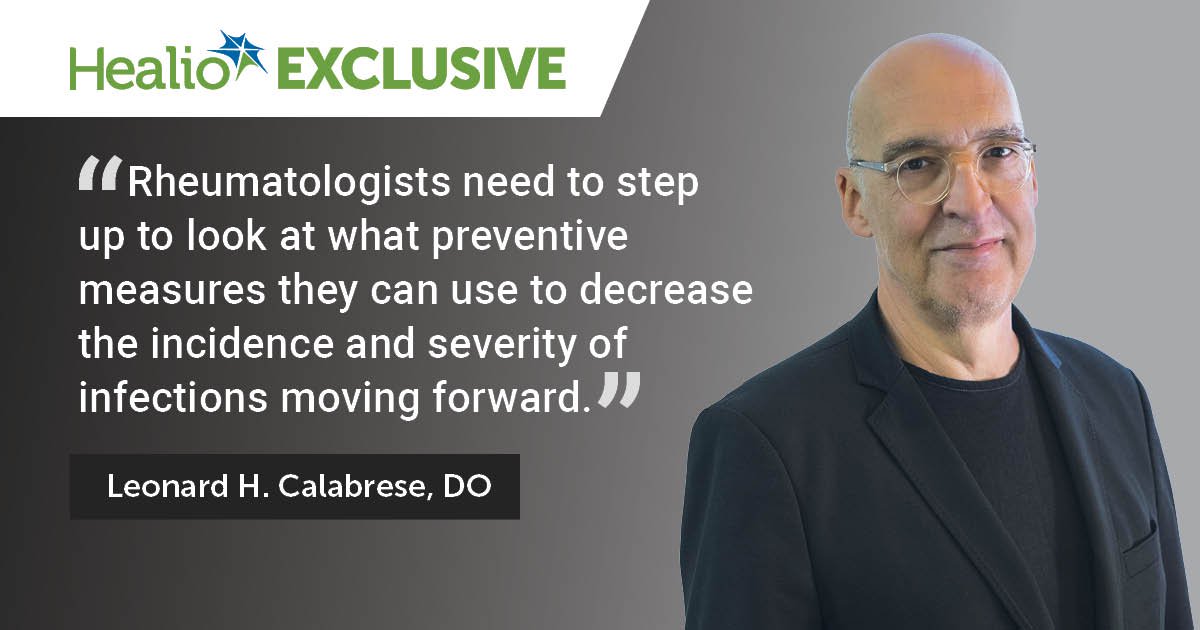August 22, 2025
11 min read
Although infection prevention is an essential part of every rheumatologist’s routine, balancing efficacy, risk and individual patient choices — all while contending with a seemingly constant flow of disinformation — can be a minefield.
“We use the broadest array of immunomodulatory and immunosuppressive medications across our diseases,” Leonard H. Calabrese, DO, professor of medicine at the Cleveland Clinic Lerner College of Medicine of Case Western Reserve University, and RJ Fasenmyer chair of clinical immunology at the Cleveland Clinic, told Healio. “While the diseases themselves are formidable and challenging, in certain diseases like vasculitis, infection is the leading cause of death, particularly within the first year.”

According to Calabrese, who is also chief medical editor for Healio Rheumatology, familiarity with all available tools for infection prevention is critical to mitigating these risks.
“Rheumatologists need to step up to look at what preventive measures they can use to decrease the incidence and severity of infections moving forward,” he said.
The first step is recognizing the most vulnerable populations.
In a 2023 review published in Joint Bone Spine, Morel and colleagues outlined some of the most important risks for individuals with chronic inflammatory and rheumatic conditions. The authors noted that viral and bacterial pneumonia are common among patients treated with disease-modifying antirheumatic drugs, while steroids and biologic medications can also put patients at risk for several infectious complications. A careful workup is essential, particularly before the start of conventional synthetic, or biological and synthetic targeted, DMARDs, they added.
Meanwhile, proper vaccination can be the first line of defense.

James Galloway
“Vaccination plays a critical role in mitigating the increased risk for infection associated with immunomodulatory therapies commonly used in rheumatology, such as methotrexate, corticosteroids and biologic agents like TNF inhibitors,” James Galloway, PhD, professor, researcher and deputy head of the Center for Rheumatic Diseases at King’s College London, told Healio. “I view vaccination as one of several practical, proactive steps that patients can take to maintain their health while on these therapies, alongside measures like avoiding high-risk environments and considering face masks during periods of heightened respiratory virus circulation.”
Morel and colleagues additionally stressed education, which can improve shared decision-making between physician and patient. These conversations are particularly important when it comes to vaccines, but rheumatologists also should be prepared to discuss infection prevention approaches like antimicrobial prophylaxis and intravenous immunoglobulin (IVIG), and to work with other specialties when necessary.
‘Prioritize open dialogue’
In the American College of Rheumatology’s guidelines for vaccination, published in Arthritis Care & Research in 2023, Bass and colleagues provided recommendations for pneumococcal, influenza and shingles vaccines, among others, as well as information about holding or delaying immunosuppressive medications.
According to Calabrese, one of the document’s co-authors, all practicing rheumatologists should familiarize themselves with these guidelines.
“This document can help sort out the changing landscape,” Calabrese said. “It is particularly important in the context of these sudden measles outbreaks and unpredictable information coming from government agencies.”
The guideline committee also offered recommendations for the use of live attenuated vaccines in the immunosuppressive setting.
“Many rheumatologists lack confidence in how to administer a live vaccine, and in which populations, as well as what the risks and benefits are,” Calabrese said.
Although B-cell depleting agents like rituximab (Rituxan, Genentech) are well known to reduce vaccine response, this is not the only class of medications that rheumatologists should be concerned about.
According to Cassandra Calabrese, DO, of the departments of rheumatic and immunologic disease and infectious disease at the Cleveland Clinic, another co-author the ACR vaccine guidelines, JAK inhibitors and interferon blockers like anifrolumab (Saphnelo, AstraZeneca) can lead to increased risk for shingles.

Cassandra Calabrese
“In the general population, you would give the shingles vaccine to people aged 50 years and up, but we can give it to our patients on these medications at age 18 if we need to,” she said.
Leonard Calabrese added that herpes zoster can potentially be fatal in patients who are immunocompromised.
“Highly morbid complications can accompany herpes zoster in our patients,” he said. “They can be life threatening in an immunocompromised population.”
The authors of the ACR vaccination guidelines also wrote that most of its recommendations are “conditional and had low quality of supporting evidence,” which demands an ongoing conversation between doctor and patient.
These conversations are additionally critical in the face of rising vaccine hesitancy.
“When discussing vaccination with patients, I prioritize open dialogue and respect for individual autonomy,” Galloway said. “I acknowledge the growing trend of vaccine hesitancy, while making clear my strong personal advocacy for vaccination, underpinned by a robust evidence base.
“My role is to ensure patients have the information they need to make informed decisions, recognizing that their backgrounds, beliefs and levels of trust in health care vary,” he added. “I make it clear that vaccination status does not influence the broader care I provide, and I approach each discussion with empathy and a commitment to shared decision-making.”
Kevin Winthrop, MD, MPH, a professor of public health and associate professor of infectious diseases and ophthalmology at the Oregon Health and Science University, encouraged calm in an increasingly politicized world.

Kevin Winthrop
“Initially, when the presidential administrations changed hands, there was certainly a lot of chaos and confusion in those first weeks,” said Winthrop, also among the co-authors of the ACR vaccine guidelines. “But the people at agencies like the CDC and FDA are communicating again. MMWR is back up and running. There are a lot of dedicated professionals still working in federal agencies that deal with vaccines. We as physicians need to keep reading studies, interpreting data, and asking colleagues at those agencies questions when we have them.”
This commitment was tested throughout the COVID-19 pandemic and continues with the flurry of conflicting information surrounding some more recent COVID-19 vaccine recommendations.
‘Let’s see what happens in the fall’
Following an announcement early in 2025, when the COVID-19 vaccine booster was recommended for “most adults” aged 18 years or older, more recent communications from HHS have recommend the shot only for individuals aged 65 years or older and other adults if they have risk factors.
“I did not like how the decision came about — it was not the usual ACIP giving advice to CDC — but I ultimately agree with the recommendation,” Winthrop said. “At this point, most people have had COVID or have had multiple doses of a vaccine or both. I am not sure we need to vaccinate people unless they are at high risk.”
However, Winthrop added that multiple risk factors — from B-cell depletion to vasculitis to high dose steroids — are common among the rheumatology patient community.
“Ultimately, in terms of rheumatology, the new COVID-19 vaccine recommendations do not affect our patients too much because they have risk factors and are going to be in the recommended group anyway,” he said.
Like many rheumatologists, Winthrop said he plans to talk to each patient, assess their history with the virus and vaccines, and then devise an individual strategy.
“Some people do not want an mRNA vaccine, so I can offer them the Novavax product,” he added. “There is also the monoclonal antibody Pemgarda (pemivibart, Pfizer), which is an option if someone is unable to take the vaccine or they have never responded to one. I can offer certain patients that as a way to protect them, particularly patients on B-cell depletion.”
With the ever-changing nature of the virus, the available vaccine products and the recommendations, Winthrop counseled patience and adaptability.
“Let’s see what happens in the fall,” he said.
Autumn will also bring with it seasonal influenza vaccination. However, this, too, has not been immune from patient hesitancy — and with some good reason, according to Leonard Calabrese.
“I am continuously disappointed with reported efficacy of recent years of influenza vaccines,” he said. “We are not doing a job that engenders a lot of confidence in vaccine efficacy.”
There is “a lot of excitement” about a universal flu vaccine, he added. However, that product is still in development with no clear timeline for availability or approval.
“We need something to break out of this mediocre level of protection we are getting from yearly flu vaccines,” Leonard Calabrese said. “The formula has not been working.”
As rheumatologists continue to adjust to the shifting landscape surrounding vaccines, other strategies may be useful in controlling infections.
‘Gray and controversial area’
The recent FDA approval of lenacapavir (Yeztugo, Gilead Sciences) for HIV prevention has injected preexposure prophylaxis into the mainstream conversation. Although this product does not have any rheumatology-specific recommendations, it may raise awareness for rheumatologists hoping to prevent other infections in their patients.
“One advantage of this product is that it is an injection every 6 months,” Cassandra Calabrese said. “This may be attractive for rheumatic or autoimmune disease patients who take multiple other medications and are interested in HIV PrEP.”
Beyond lenacapavir, rheumatologists may have to dig to find information on other prophylactic products.
“The evidence base for routine antimicrobial prophylaxis in rheumatology is limited,” Galloway said. “Most data derive from populations with advanced HIV or chronic pulmonary disease, rather than autoimmune conditions. Consequently, antimicrobial prophylaxis is not a routine component of infection prevention in immunosuppressed rheumatology patients. Instead, I adopt an individualized approach.”
However, one setting where antimicrobial prophylaxis could be used is in pneumocystis jirovecii pneumonia (PJP).
In a 2022 study published in Chest, Park and colleagues aimed to investigate whether primary prophylaxis for PJP is justified in patients being treated with rituximab. The retrospective analysis included 3,524 patients overall and 559 with rheumatic diseases with exposure to rituximab in South Korea between 2002 and 2018. Prophylactic trimethoprim-sulfamethoxazole was administered to 1,001 patients, with 2,523 controls.
Results showed a significantly lower incidence of PJP in the prophylaxis group (adjusted sub-distribution HR = 0.2; 95% CI, 0.1-0.42), compared with controls. Regarding the safety of this intervention, the results, based on 10 adverse drug reactions, demonstrated that the number needed to harm was 101 (range, 61.9-261.1), while the number needed to prevent one PJP infection was 32 (range, 24.8-39.4).
“One of the few settings where we may consider preexposure antimicrobial prophylaxis is pneumocystis pneumonia,” Cassandra Calabrese said. “However, this is a gray and controversial area.”
One concern is that there are no clear guidelines on this matter, she said.
“Also, we have not yet identified one clear risk factor to determine who is most likely to benefit from prophylaxis,” she added.
Prolonged steroid use is a main risk factor for PJP, but underlying disease and concomitant medications are also important to consider, notably among patients with ANCA-associated vasculitis taking rituximab, Cassandra Calabrese said.
Similar, and perhaps even greater, uncertainties surround the use of antimicrobial prophylaxis in the immunocompromised patient population, according to Leonard Calabrese.
“One area of both interest and importance is our patients with significant underlying pulmonary disease, whether due to their immune disorder, such as interstitial lung disease, or other complicated disorders such as chronic obstructive pulmonary disorder (COPD),” he said.
According to Galloway, the use of pre-exposure antimicrobial prophylaxis in these settings is highly individualized, based on limited data, and guided by both organ- and patient-specific risk factors.
“If a patient with an autoimmune disease also has COPD and experiences recurrent chest infections, I would consider prophylaxis based on established COPD guidelines,” he said. “However, for patients with immunosuppression who experience sporadic infections of varied origin — such as cellulitis, then a chest infection, then dental infections — prophylaxis is unlikely to offer benefit due to the differing underlying organisms and causes. Ultimately, antimicrobial prophylaxis in rheumatology is reserved for carefully selected cases, guided by organ-specific or patient-specific risk factors.”
Chronicity is often a major factor informing the use of prophylactic therapy, according to Winthrop.
“We see recurrent cellulitis or recurrent urinary tract infections,” he said. “In those patients, we can consider antimicrobial prophylaxis.”
Regarding post-exposure prophylaxis, pemivibart remains the primary choice for COVID prevention, especially in B-cell depleted patients, according to Cassandra Calabrese.
Beyond this product, the use of post-exposure prophylaxis depends greatly on the region and the endemic infections, according to Galloway.
“Post-exposure prophylaxis in rheumatology is generally aligned with national guidelines for the wider population,” he said. “For bacterial exposures, post-exposure prophylaxis is typically indicated for tuberculosis or meningococcal disease after documented contact, regardless of underlying autoimmune disease. Immunosuppressed patients in these scenarios would receive the same post-exposure prophylaxis as the general population.”
The situation is similar for viral infections, Galloway added.
“In certain viral exposures, notably varicella and measles, immunoglobulin-based post-exposure prophylaxis can be considered for immunosuppressed patients lacking prior immunity,” he said. “Therefore, I routinely assess patients’ childhood vaccination status and prior varicella exposure before initiating immunosuppression.
If a patient lacks documented or serological evidence of immunity and has had a significant exposure, I would promptly arrange for antibody testing and consider immunoglobulin therapy,” he added. “In practice, such scenarios are rare but underscore the need for vigilance.”
Patients who may require an infection prevention approach like IVIG are also rare. However, understanding how and when to use this strategy could mean the difference between life and death.
IVIG: Valuable but ‘not a standard approach’
IVIG can be beneficial for certain populations who are at particular risk for increased incidence and severity of infections due to secondary hypogammaglobulinemia, which can occur in patients taking B-cell depleting therapies, mycophenolate and steroids, according to Cassandra Calabrese.
“If patient is found to have low IgG, the first step is to repeat the level to confirm it was not transiently low from something like systemic steroid use,” she said.
Winthrop added that the need for IVIG “is something we work up” in patients who are severely IgG deficient and have recurrent infections.
Meanwhile, the rise of CAR T-cell therapy in cancer has opened yet another new arena in which rheumatologists can find themselves managing hypogammaglobulinemia, and reaching for IVIG, according to Leonard Calabrese.
“In cancer, 10% to 20% of patients undergoing CAR T-cell therapy will end up with hypogammaglobulinemia,” he said. “IVIG has become a cottage industry for these patients. It is a complicated workup. Rheumatologists need to be engaged on this.”
Information is available for clinicians unfamiliar with IVIG as an infection prevention strategy, according to Galloway.
“The use of IVIG in rheumatology is guided by national protocols in the United Kingdom, based on documented hypogammaglobulinemia and a history of recurrent infections,” he said. “This situation is most relevant to patients who have received B-cell depleting therapies, such as rituximab, particularly when combined with other potent immunosuppressive agents like high-dose corticosteroids or cyclophosphamide.”
Knowing which patients are at the highest risk is also critical, Galloway added.
“For instance, patients with systemic lupus erythematosus or vasculitis are more prone to such immunoglobulin deficiencies compared to those with rheumatoid arthritis,” he said.
However, Galloway also cautioned that not every rheumatologist may need to use this approach.
“Importantly, IVIG replacement is not a standard approach for most patients on immunosuppression,” he said. “I also emphasize the importance of ongoing immunoglobulin monitoring in patients receiving rituximab to ensure that if levels do decline, we consider alternative immunomodulatory strategies to avoid the need for IVIG.”
Regardless of the infection prevention method used, rheumatologists should be working with other specialists to ensure optimized protection in a world where information available to patients outside the clinic is increasingly suspect and politicized.
Collaborative approach
“Unfortunately, there has been a swell of distrust surrounding vaccines and other information coming from government agencies driven in part by misinformation and disinformation prevalent on the web,” Winthrop said. “We all need to pay attention to the information being provided, consider its source and stay up to date. Peer-reviewed, top flight scientific journals remain a trusted source.”
An important way to remain current with the shifting landscape is to communicate with other health care professionals.
“Managing patients with autoimmune and rheumatic diseases necessitates a collaborative, multidisciplinary approach,” Galloway said. “Immunologists provide essential input on evaluating immune competence in patients with recurrent or atypical infections, such as by assessing T-cell, B-cell function and immunoglobulin levels depending on the infection pattern. Infectious diseases specialists offer invaluable expertise when infections arise, helping to balance eradication of infection with the safe continuation of immunosuppression.”
These discusses are likely to grow even more critical as the rheumatology therapeutic armamentarium evolves.
“As our therapies for autoimmune disease become increasingly sophisticated, these collaborations ensure that our focus extends beyond disease control to encompass comprehensive infection prevention,” Galloway said. “I consider this a cornerstone of modern rheumatology practice, reinforcing my commitment to working closely with colleagues in these specialties to safeguard patient wellbeing.”
Additionally, communication is not just for doctors talking with other doctors — the patient must also be involved.
“I always encourage my patients to let me know when they may have been exposed to an infection like the flu or COVID, or if they have travelled anywhere that other infections may be endemic,” Cassandra Calabrese said. “Risk prevention starts with communication about those risks.”
For Leonard Calabrese, every rheumatologist should feel compelled to be as informed as possible about infection prevention.
“There is a prevalent risk to a small but significant number of patients that we own,” he said. “The potential complications are life threatening. It is something that we are obliged to stay up to date on.”
References:
Bass AR, et al. Arthritis Care Res. 2023;doi: 10.1002/acr.25045.
Morel J. Joint Bone Spine. 2023;doi:10.1016/j.jbspin.2023.105568.
Park JW, et al. Chest. 2022;doi:10.1016/j.chest.2021.11.007.
For more information:
Cassandra Calabrese, DO, can be reached at CALABRC@ccf.org.
Leonard H. Calabrese, DO, can be reached at CALABRL@ccf.org.
James Galloway, PhD, can be reached at james.galloway@kcl.ac.uk.
Kevin Winthrop, MD, MPH, can be reached at winthrop@ohsu.edu.










